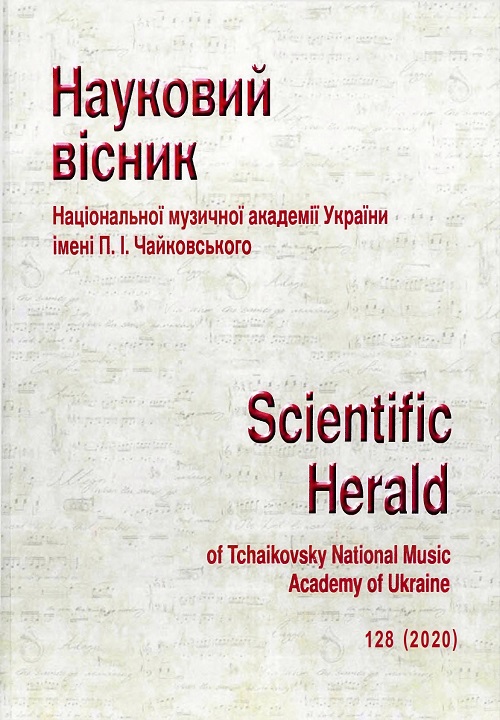Glissando on the Piano Keyboard: «Extended» Interpretation of the Traditional Method of Sound Extraction (historical aspect)
DOI:
https://doi.org/10.31318/2522-4190.2020.128.215197Keywords:
extended piano techniques, glissando, glissando on the keyboard, works for clavier / piano solo, tone-painting, virtuosityAbstract
Relevance of the study and scientific novelty of the research are determined by its main objectives — to study glissando on keyboard from the position of extended piano techniques and justify its inclusion into this system; to show the history of development this method of playing; to clarify the various ways of using glissando in piano music of the 20th — beginning of the 21st centuries.
Methodology of the research: historical — is to show the process of becoming glissando on the keyboard: from its inception in 17th century music to an active development over several centuries; systemic — is to present “extended piano techniques” as a system of non-standard ways of playing the piano, which allow to achieve many interesting sound effects, as well as demonstrate the virtuoso component of the composition; comparative — consists in analytically presenting and comparing two ideas for using keyboard glissando in works, how they affect the disclosure of the artistic intent of each composer; performance method consists in studying the feasibility of using a glissando on a keyboard and its types in musical works of various composer’s schools of several centuries.
Conclusions. The research of the Klavier works at the end of 17th — the beginning of the 21st centuries demonstrates using glissando is to engage a new element that clearly reveals the virtuoso and sound component of the work. Indeed, virtuosity and sound creation have become the main factors behind the introduction of keyboards glissandi. Also, the evolution of music has led to an increase in the number and variety of keyboard’s glissandi types. Initially, composers used one way of gliding. Then, the combination of several variants of glissando became the popular technical solution of many authors. Thus, at the beginning of the 21st century, the composers began to build a whole work on the keyboard glissandi.
So, the significant development; huge transformations of ideas of its use; various modifications according to its technical and color characteristics allow to be viewed glissando on the keyboard from the perspective of its «extended» interpretation.
Significance of the research. Until now, most Ukrainian scientists haven’t considered glissando on the keyboard to be included to the system of extended piano techniques. In this work the analytically grounded positions which allow to plug the key glissando and its modifications in the system of extended methods playing the piano.
Downloads
References
Glissando [Glissando] (1991). Musical Encyclopedic Dictionary [Muzykal’nyj jenciklopedicheskij slovar’]. Moscow: Soviet Encyclopedia, p. 139 [in Russian].
Extended techniques [online]. Available at: http://musicinmovement.eu/glossary/extended-technique (Accessed 12.11.2019) [in English].
Proulx, J.-F. (2009). A Pedagogical Guide to Extended Piano Techniques: Doctor of Musical Arts. Temple University. Philadelphia, Pennsylvania, 138 p. [in English].
Reiko, I. (2005). The Development of Extended Piano Techniques in Twentieth-Century American Music: Doctor of Music. The Florida State University College of Music. Florida, 126 p. [in English].
Vaes, L. (2009). Extended Piano Techniques in Theory, History and Performance Practice: Doctoral thesis. Leiden University. Leiden, 1081 р. [in English].
Downloads
Published
How to Cite
Issue
Section
License
Our journal abides by the CREATIVE COMMONS copyright rights and permissions for open access journals.
Authors, who are published in this journal, agree to the following conditions:
The authors reserve the right to authorship of the work and pass the first publication right of this work to the journal under the terms of a Creative Commons Attribution License, which allows others to freely distribute the published research with the obligatory reference to the authors of the original work and the first publication of the work in this journal.
The authors have the right to conclude separate supplement agreements that relate to non-exclusive work distribution in the form in which it has been published by the journal (for example, to upload the work to the online storage of the journal or publish it as part of a monograph), provided that the reference to the first publication of the work in this journal is included.




